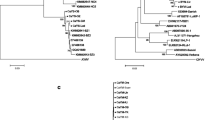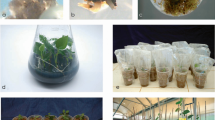Abstract
A viral disease was identified on geraniums (Pelargonium spp.) grown in a greenhouse at the Institute of Himalayan Bioresource Technology (IHBT), Palampur, exhibiting mild mottling and stunting. The causal virus (Cucumber mosaic virus, CMV) was identified and characterized on the b0asis of host range, aphid transmission, enzyme linked immunosorbent assay (ELISA), DNA-RNA hybridization and reverse transcription polymerase chain reaction (RT-PCR). A complete coat protein (CP) gene was amplified using degenerate primers and sequenced. The CP gene showed nucleotide and amino acid homology up to 97%–98% and 96%–99%, respectively with the sequences of CMV subgroup II. The CP gene also showed homologies of 75%–97% in nucleotide and 77%–96% in amino acid with the CMV Indian isolates infecting various crops. On the basis of sequence homology, it was concluded that CMV-infecting geraniums in India belong to subgroup II
Similar content being viewed by others
Abbreviations
- CMV:
-
Cucumber mosaic virus
- CP:
-
coat protein
- ELISA:
-
enzyme linked immunosorbent assay
- RT-PCR:
-
reverse transcription-polymerase chain reaction
References
Albouy J and Morand J C 1976 Les viroses du pelargonium en France. Etat des recherches et possibilities de Selection sanitaire;Rev. Hort. 168 57–59
Choi S K, Choi J K, Park W M and Ryu K H 1999 RT-PCR detection and identification of three species of cucumoviruses with a genus-specific single pair of primers;J. Virol. Methods 83 67–73
Corpet F 1988 Multiple sequence alignments with hierarchical clustering;Nucleic Acids Res. 16 10881–10890
Deyong Z, Willingmann P, Heinze C, Adam G, Pfunder M, Frey B and Frey J E 2005 Differentiation ofCucumber mosaic virus isolates by hybridization to oligonucleotides in a microarray format;J. Virol. Methods 123 101–108
European and Mediterranean Plant Protection Organization (EPPO) 1992 Certification Scheme. Pathogen tested material of pelargonium;EPPO Bull. 22 285–296
Franck A and Loebenstein G 1995 Pelargonium; inVirus and virus-like diseases of bulb and flower crops (eds) G Loebenstein, R H Lawson and A A Brunt (Chichester: John Wiley) pp 514–527
Hammond R W 2003 Phylogeny of isolates ofPrunus necrotic ringspot virus from the Ilarvirus Ringtest and identification of group-specific features;Arch. Virol. 14 1195–1210
Higgins D, Thompson J, Gibson T, Thompson J D, Higgins D G and Gibson T J 1994 CLUSTAL W: improving the sensitivity of progressive multiple sequence alignment through sequence weighting, position-specific gap penalties and weight matrix choice;Nucleic Acids Res. 22 4673–4680
Hu J S, Li H P, Barry K, Wang M and Jordan R 1995 Comparison of dot blot ELISA and RT-PCR assays for detection of twoCucumber mosaic virus isolates infecting banana in Hawaii;Plant Dis. 79 902–206
Hu C C, Aboul-Ata A E, Naidu R A and Ghabrial SA 1997 Evidence for the occurrence of two distinct subgroups of Peanut stunt cucumovirus strains: molecular characterization of RNA 3;J. Gen. Virol. 78 929–939
Ilardi V, Mazzei M, Loreti S, Tomassoli L and Barba M 1995 Biomolecular and serological methods to identify strains ofCucumber mosaic cucumovirus on tomato;EPPO Bull. 25 321–327
Korbin M and Kaminska M 1998 Characterization ofCucumber mosaic cucumovirus isolates;Phytopath. Polonica 16 71–84
Noordam D 1973Identification of plant viruses: Methods and experiments (New Delhi: Oxford and IBH Publishing Co.) pp 1–207
Ohshima K, Yamaguchi Y, Hirota R, Hamamoto T, Tomimura K, Tan Z, Sano T, Azuhata F, Walsh J A, Fletcher J, Chen J, Gera A and Gibbs A 2002 Molecular evolution ofTurnip mosaic virus: evidence of host adaptation, genetic recombination and geographical spread;J. Gen. Virol. 83 1511–1521
Owens J and Palukaitis P 1988 Characterization ofCucumber mosaic virus. I. Molecular heterogeneity mapping of RNA 3 in eight CMV strains;Virology 69 496–502
Owens J, Shintaku M, Aeschleman P, Tahar S F and Palukaitis P 1990 Nucleotide sequence and evolutionary relationships ofCucumber mosaic virus (CMV) strains, CMV RNA 3;J. Gen. Virol. 71 2243–2249
Paludan N 1975 Sunde pelargonier. 4. Virussygdomme;Gart. Tid. 21 353–356
Paludan N 1976 Virus diseases inPelargonium hortorum specially concerningTomato ringspot virus;Acta Hortic. 59 119–130
Palukaitis P, Roossinck M, Dietzgen R G and Francki R I B 1992Cucumber mosaic virus;Adv. Virus Res. 41 281–348
Palukaitis P and Zaitlin M 1997 Replicase-mediated resistance to plant virus diseases;Adv. Virus Res. 48 349–377
Quacquarelli A and Gallitelli D 1979 Tre viroisi del geranio in Puglia;Phytopath. Med. 18 61–70
Rao B R R, Kaul P N, Gopal R M and Ramesh S 2000 First observation of little leaf disease and its impact on the yield and composition of the essential oil of rose-scented geranium (Pelargonium sp.);Flavour Fragr. J. 15 137–140
Rizos H, Gunn L V, Pares R D and Gillings M R 1992 Differentiation ofCucumber mosaic virus isolates using the polymerase chain reaction;J. Gen. Virol. 73 2099–2103
Roossinck M J 2002 Evolutionary history ofCucumber mosaic virus deduced by phylogenetic analyses;J. Virol. 76 3382–3387
Roossinck M J, Zhang L and Hellward K 1999 Rearrangements in the 5' nontranslated region and phylogenetic analyses ofCucumber mosaic virus RNA 3 indicate radial evolution of three subgroups;J. Virol. 76 6752–6758
Sambrook J, Fritsch E F and Maniatis T 1989Molecular cloning: A laboratory manual (New York: Cold Spring Harbor Laboratory)
Schmatz R and Kegler H 1979 Untersuchungen zur mechanischen Ubertragung von Viren der pelargonie auf krautige Wirtspflanzen;Arch. Gartenbau. 27 377–385
Sharma A, Mahinghara B K, Singh A K, Kulshrestha S, Raikhy G, Singh L, Verma N, Hallan V, Ram R and Zaidi A A 2005 Identification, detection and frequency of lily viruses in Northern India;Sci. Hortic. 106 213–227
Sialer M M, Cillo F, Barbarossa L and Gallitelli D 1999 Differentiation ofCucumber mosaic virus subgroups by RT-PCRRFLP;J. Plant Pathol. 81 145–148
Srivastava A and Raj S K 2004 High molecular similarity among Indian isolates ofCucumber mosaic virus suggests a common origin;Curr. Sci. 87 1126–1131
Suzuki M, Kuwata S, Kataoka J, Masuta C, Nitta N and Takanami Y 1991 Functional analysis of deletion mutants ofCucumber mosaic virus RNA 3 using anin vitro transcription system;Virology 183 106–113
Szilassy D, Sala'nki K and Bala'zs E 1999 Molecular Evidence for the existence of two distinct subgroups inCucumber mosaic cucumovirus;Virus Genes 18 221–227
Verma N, Singh A K, Singh L, Kulshrestha S, Raikhy G, Hallan V, Ram R and Zaidi A A 2004 Occurrence ofCucumber mosaic virus inGerbera jamesonii from India;Plant Dis. 88 1161
Verma N, Singh L, Singh A K, Kulshreshtha S, Raikhy G, Hallan V, Ram R and Zaidi A A 2005 Ornithogalum: a new host ofCucumber mosaic virus (CMV) from India;Plant Pathol. 54 256
Verma N, Singh A K, Singh L, Raikhy G, Kulshrestha S, Singh M K, Hallan V, Ram R and Zaidi A A 2005Cucumber mosaic virus (CMV) infectingAlstroemeria hybrids in India;Aus. Plant Pathol. 34 119–120
Wahyuni W S, Dietzen R G, Handa K and Francki R I B 1992 Serological and biological variation between and within subgroup I and II strains ofCucumber mosaic virus;Plant Pathol. 41 282–297
Author information
Authors and Affiliations
Corresponding author
Additional information
IHBT Communication Number: 0553. (The complete coat protein gene sequence ofCucumber mosaic virus isolate geranium has been submitted to EMBL database with accession No. AJ866272)
Rights and permissions
About this article
Cite this article
Verma, N., Mahinghara, B.K., Ram, R. et al. Coat protein sequence shows thatCucumber mosaic virus isolate from geraniums (Pelargonium spp.) belongs to subgroup II. J. Biosci. 31, 47–54 (2006). https://doi.org/10.1007/BF02705234
Received:
Accepted:
Published:
Issue Date:
DOI: https://doi.org/10.1007/BF02705234




